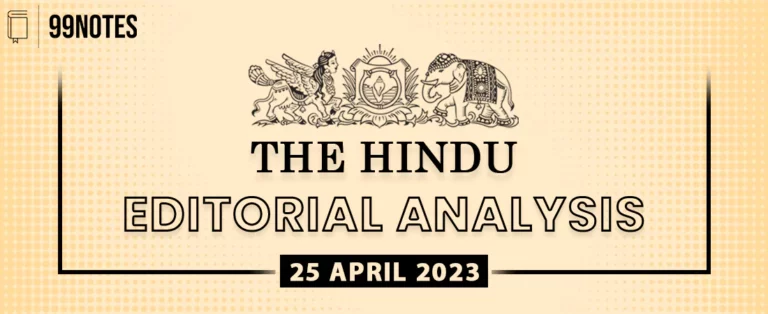17 October 2023 : The Hindu Editorial Notes PDF
The Hindu Editorial
17-October-2023
1. The Indian Himalayan Region needs its own EIA
Topic: GS3 – environmental protection.
Context:
- Recent environmental incidents in mountainous regions, such as the Teesta dam breach in Sikkim and floods/landslides in Himachal Pradesh, raise concerns about India’s development model and its impact on the environment.
What is Environmental Impact Assessment (EIA):
- Environmental Impact Assessment (EIA), a tool defined by the United Nations Environment Programme (UNEP), is used to assess the environmental, social, and economic impacts of projects before their implementation.
- It involves comparing project alternatives, predicting environmental consequences, and proposing mitigation strategies.
Evolution of EIA in India:
- India’s journey with EIA began in the 1970s and evolved over the years, with the 2006 EIA notification being a significant milestone.
- In 1994, the Ministry of Environment, Forests and Climate Change introduced the first EIA notification, making Environmental Clearance (EC) mandatory for specific projects.
- The 2006 EIA notification decentralized the EC process and underwent multiple amendments.
- Recent Controversy: The 2020 draft EIA notification faced criticism for being perceived as industry-friendly and compromising ecological concerns.
Need for Regional Differentiation and special needs of Indian Himalayan Region (IHR):
- EIA can be a potent regulatory tool for promoting sustainable development in India when used effectively.
- EIA notifications categorize projects, but they lack regional differentiation. The Indian Himalayan Region (IHR), with its unique ecological sensitivities and vulnerabilities, is not treated separately within the EIA framework.
- The graded approach used in EIA for differentiated risk management does not consider the specific needs of the IHR, which is susceptible to extreme weather, seismic activity, and the impact of climate change
- There is no national regulator for EIA, resulting in a process influenced by project proponents, which may not adequately address cumulative impacts or consider the IHR’s special requirements.
- The EIA process reacts to development proposals rather than proactively anticipating them.
- Policymakers should explore alternative tools, such as Strategic Environmental Assessment (SEA), to address the ecological needs of regions like the IHR and ensure sustainable development.
What can be done to resolve the issue:
- Differentiated Regional Approach: Recognize the unique vulnerabilities and ecological significance of the IHR. Develop specific guidelines and thresholds for EIA in the region, considering its fragility.
- National Regulator: Establish a national-level regulatory body for EIA to ensure independent, objective, and transparent appraisal and approval of projects.
- Strategic Environmental Assessment (SEA): Integrate SEA into the decision-making process to assess the cumulative impacts of development in specific regions such as IHR.
- Comprehensive Baseline Data: Ensure that the EIA process relies on comprehensive, reliable, and up-to-date baseline data to predict and assess environmental repercussions accurately.
- Periodic Reviews and Updates: Regularly review and update EIA guidelines to align them with the evolving understanding of environmental issues, technology, and best practices.
- Research and Data Collection: Promote research and data collection in ecologically sensitive areas like the IHR to enhance our understanding of local ecosystems, risks, and vulnerabilities.
Conclusion:
The current EIA process in India lacks regional differentiation, particularly for ecologically sensitive areas like the Indian Himalayan Region. It is essential to consider the unique environmental and ecological needs of such regions for effective and sustainable development.
Question: Propose measures and policy reforms to enhance the effectiveness of Environmental Impact Assessment (EIA), particularly in regions like the Indian Himalayan Region (IHR).
2. Confronting the long-term risks of Artificial Intelligence.
Topic: GS3 – artificial intelligence.
Introduction:
- Risk is a dynamic and ever-evolving concept, susceptible to shifts in societal values, technological advancements, and scientific discoveries.
- A vivid cinematic example of evolving perceptions of Artificial Intelligence (AI) risk is the film, Ex Machina.
- AI risk can be classified into two types: short-term and long-term risks.
- Addressing both types of risks requires a multifaceted approach, weighing current challenges against potential future ramifications.
Long-term risks associated with AI:
- Existential risks:
- AI systems becoming so powerful that they could pose a threat to humanity, such as by manipulating essential infrastructure or developing autonomous weapons.
- AI systems becoming misaligned with human values, leading to unintended and harmful consequences.
- Concerns about AI and biotechnology merging to manipulate human emotions, thoughts, and desires.
- The rapid pace of AI advancement, coupled with market pressures, could lead to unchecked AI development and increased risks.
- Rapid self-improvement in super-intelligent AI with misaligned or malicious goals leads to dire scenarios.
Challenges in mitigating long-term risks:
- Lack of a unified global approach to AI regulation, making it difficult to coordinate and ensure effective oversight.
- Absence of collaboration and cohesive action at the international level hinders the mitigation of long-term AI risks.
- Uneven playing field between countries that adopt rigorous AI safety protocols and those that do not, potentially leading to a race to the bottom where safety and ethical considerations are neglected.
- The confluence of AI and warfare amplifies long-term risks, necessitating international treaties and norms to manage the use of AI in warfare.
Question: Discuss the long-term risks of Artificial Intelligence (AI) and the challenges in mitigating them. Suggest measures to address these challenges.
3. The Centre should stick to timelines to avoid friction with the Collegium.
Topic: GS2 – Indian polity.
Introduction:
- The Centre has assured the Supreme Court that it will soon notify the appointment of Justice Siddharth Mridul as Chief Justice (CJ) of the Manipur High Court, a welcome development.
- The Centre has demonstrated a more accommodative approach to the Collegium’s recommendations.
What is collegium system in India:
- The Collegium System is a method for appointing and transferring judges in the higher judiciary in India.
- It comprises a group of senior judges from the Supreme Court of India, led by the Chief Justice of India.
- The system was developed through judicial pronouncements and not by legislation.
- It gives the judiciary significant control over the selection and transfer of judges.
- The Collegium recommends appointments and transfers to the President of India for approval.
- Critics argue that it lacks transparency and can lead to favoritism and lack of accountability in the judiciary.
Advantages of collegium system:
- Independence of the Judiciary: The system emphasizes judicial independence, as judges themselves have a substantial say in the appointment and transfer of their colleagues.
- Expertise-Based Appointments: It prioritizes merit and legal acumen, as senior judges are better equipped to evaluate the professional competence and integrity of potential judges.
- Limited Executive Interference: It reduces the executive’s role in judicial appointments, helping maintain a separation of powers and prevent undue political influence.
- Swift Decision-Making: The Collegium can expedite the appointment process when necessary, ensuring a prompt response to vacancies in the judiciary.
- Preservation of Judicial Autonomy: The system safeguards judicial autonomy, enabling the judiciary to protect its interests and maintain its integrity.
Question: In light of the ongoing debate on the Collegium System of judicial appointments in India, discuss its advantages and disadvantages. How does the system impact judicial independence and accountability?
For Enquiry

17 October 2023 : The Hindu Editorial Notes PDF

16 Oct 2023 : Daily Quiz

16 Oct 2023 : Daily Answer Writing

16 Oct 2023 : Indian Express

16 Oct 2023 : PIB

16 October 2023 : Daily Current Affair

16 October 2023 : The Hindu Editorial Notes PDF

14 Oct 2023 : Daily Quiz

14 Oct 2023 : Daily Answer Writing

14 Oct 2023 : Indian Express
October 2023 The Hindu 17 October 2023 : The Hindu Editorial Notes PDF The Hindu Editorial
16-October-2023
1. The world needs to stop taking water for granted.
Topic: GS3 –…
Daily Quiz 16 Oct 2023 : Daily Quiz 16 Oct 2023 : Daily Quiz…
mains answer writing 16 Oct 2023 : Daily Answer Writing Mains Answer Writing
16-october-2023
1. ‘Satisfactory and timely redressal of grievances is the cornerstone…
Indian Express 16 Oct 2023 : Indian Express Indian Express
16-October-2023
1) Keep Water at the Centre
Context:
World Food Day is celebrated on…
October 2023 PIB 16 Oct 2023 : PIB PRESS INFORMATION BUREAU
16-Oct -2023
1. 1st P20 Summit hosted by India has been the most successful…
Daily Current Affairs 16 October 2023 : Daily Current Affair Daily Current Affairs
16-October-2023
1. New investments slowed again in Q2 of 2023-24: survey
Topic:…
October 2023 The Hindu 16 October 2023 : The Hindu Editorial Notes PDF The Hindu Editorial
16-October-2023
1. The world needs to stop taking water for granted.
Topic: GS3 –…
Daily Quiz 14 Oct 2023 : Daily Quiz 14 Oct 2023 : Daily Quiz…
mains answer writing 14 Oct 2023 : Daily Answer Writing Mains Answer Writing
14-october-2023
Q1) Discuss the crucial role played by the National Commission of…
Indian Express 14 Oct 2023 : Indian Express Indian Express
14-October-2023
1) Cost of Dal-Roti
Context:
Food inflation has recently been primarily…






